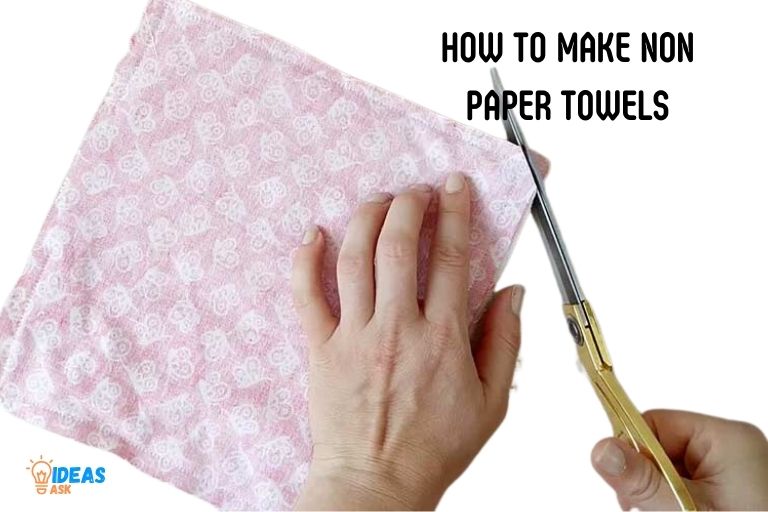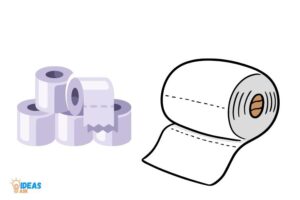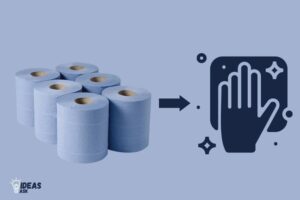How to Make Non Paper Towels? 5 Steps!
To make non-paper towels, you will need items like old bath towels or flannel fabric, sewing machine, thread, scissors, and a ruler.
The steps include measuring and cutting the fabric, sewing the pieces together, and finally, finishing the edges with a straight stitch or zigzag stitch for a neat look.
Making non-paper towels is a simple process that involves gathering supplies such as old bath towels or flannel fabric, a sewing machine, and basic sewing supplies.
The fabric is then measured and cut into the desired towel sizes. These pieces are then sewn together to create a double-layered towel, and the edges are finished with a straight stitch or a zigzag stitch to prevent fraying.
This is a great way to recycle old towels or fabric and create a reusable and environmentally friendly alternative to disposable paper towels.
In a world where environmental sustainability is increasingly important, making non-paper towels is an easy and effective way to contribute to this effort.
Not only do these homemade towels reduce waste, but they also save money in the long run. Whether you’re a seasoned sewing enthusiast or a beginner, creating non-paper towels is a fun and rewarding project to undertake.
5 Steps to Make Non-Paper Towels
| Step | Materials Needed | Instructions |
|---|---|---|
| 1 | Old Cotton Clothes, Scissors | Cut the clothes into medium-sized towels |
| 2 | Sewing machine or Needle, Thread | Sew around the edges of the towels |
| 3 | Patterned Fabric, Iron, Fabric Glue | Apply the patterned fabric to one side of the towel using iron and fabric glue |
| 4 | Iron | Iron the towel again to ensure the patterned fabric is well adhered |
| 5 | Your reusable, non-paper towel is ready for use! |
Key Takeaway

Five Facts About Making Non Paper Towels
What Are Non-Paper Towels?
When it comes to household cleaning, paper towels have been the go-to option for years. However, non-paper towels are starting to gain popularity, and for good reason.
We will define what non-paper towels are, provide examples of them, explain their benefits, and compare their effectiveness to that of paper towels.
Define What Non-Paper Towels Are
Non-paper towels are a more sustainable alternative to their paper counterparts. Unlike paper towels, non-paper towels are made from reusable materials such as cotton, bamboo, or microfiber.
These types of towels are designed for multi-purpose cleaning and can be washed and used again and again.
Provide Examples Of Non-Paper Towels
There are various types of non-paper towels available in the market, including:
- Cotton cleaning cloths
- Microfiber towels
- Bamboo towels
- Swedish dishcloths
Explain The Benefits Of Using Non-Paper Towels
Using non-paper towels comes with many benefits, including:
- Reducing waste: Non-paper towels are reusable, making them more environmentally friendly and reducing the amount of waste produced.
- Saving money: While non-paper towels may be more expensive to purchase initially, their reusable nature means that they can save you money in the long run.
- Better cleaning: Non-paper towels are more effective when it comes to cleaning surfaces due to their superior absorbency and durability.
- Healthier: Non-paper towels don’t contain any chemicals like paper towels do, making them safer to use around food and on surfaces you come in contact with such as tables.
Effectiveness Comparison Between Non-Paper Towels And Paper Towels
When it comes to effectiveness, non-paper towels come out on top for several reasons:
- Absorbency: Non-paper towels are more absorbent than paper towels, which means they can clean up more spills with fewer sheets.
- Durability: Non-paper towels are stronger than paper towels and can withstand more rough usage.
- Multi-purpose: Non-paper towels are designed for multiple uses such as cleaning surfaces, drying dishes, and wiping hands, while paper towels are only meant for one-time use.
Non-paper towels are the better alternative to paper towels due to their sustainability, effectiveness, and cost-saving benefits.
By opting for non-paper towels, you can create a healthier environment for you and your family while reducing waste and saving money in the long run.
Types Of Materials Needed
Non-paper towels are becoming increasingly popular as an eco-friendly alternative to traditional paper towels. They are not only kinder to the planet, but can also save you money in the long run.
Making your own non-paper towels is surprisingly easy, so let’s get started! We’ll be discussing the different materials needed for making non-paper towels.
When making non-paper towels, you will need a few key materials. These include:
- Fabric – the main component of your non-paper towels. It is important to choose a fabric that is absorbent and durable. Some popular choices include cotton, linen, and bamboo.
- Sewing machine – you’ll need a sewing machine to create the towels. If you don’t have one already, you may be able to borrow one from a friend or family member.
- Thread – make sure to choose a high-quality thread that won’t break easily.
- Scissors – you’ll need a good pair of fabric scissors to make straight, clean cuts.
- Ruler or measuring tape – this will help you to measure your fabric accurately.
- Cutting mat – if you’re using a rotary cutter, a cutting mat is essential for protecting your work surface and achieving accurate cuts.
How To Source And Prepare The Materials?
Once you know what materials you need, it’s time to source and prepare them.
Here’s what you need to do:
- Fabric: You can buy fabric in-person at a fabric or craft store, or online from retailers such as etsy, amazon, or spoonflower. Make sure to choose a fabric that is absorbent and durable. Wash and dry your fabric before cutting and sewing to prevent shrinking.
- Sewing machine: If you don’t already have a sewing machine, you can borrow one from a friend or family member. Alternatively, you can rent or buy one online.
- Thread: Choose a high-quality thread that won’t break easily. Polyester or cotton threads are both good options.
- Scissors: Invest in a good pair of fabric scissors to make straight, clean cuts. Avoid using them for anything else, as this can dull the blades.
- Ruler or measuring tape: A ruler or measuring tape will help you to measure your fabric accurately. Look for a transparent ruler to make it easy to see your fabric underneath.
- Cutting mat: If you’re using a rotary cutter, you’ll need a cutting mat to protect your work surface and achieve accurate cuts. Self-healing cutting mats are a good choice, as they are durable and can be used again and again.
Pros And Cons Of Each Material Type
Each material type has its own strengths and weaknesses when making non-paper towels.
Here are some pros and cons to consider:
Cotton
- Pros – absorbent, durable, widely available.
- Cons – may shrink in the wash, not as eco-friendly as other options.
Linen:
- Pros – absorbent, durable, eco-friendly.
- Cons – more expensive than other options, can wrinkle easily.
Bamboo:
- Pros – eco-friendly, absorbent, naturally anti-bacterial.
- Cons – can be more expensive than other options, may not be as durable as cotton or linen.
Choosing the right materials for making non-paper towels is key to their effectiveness and eco-friendliness.
With the right materials and tools, you’ll be able to create your own non-paper towels that are both functional and beautiful.
Step-By-Step Guide For Making Non-Paper Towels
How To Make Non-Paper Towels: A Comprehensive Guide
Switching to non-paper towels not only reduces your carbon footprint, but it also saves you a significant amount of money down the line.
Follow this step-by-step guide to create your own non-paper towels!
Required Materials
Before you can begin making your homemade non-paper towels, you’ll need to have the following materials on hand:
- Cotton flannel (3 yards)
- Scissors
- Sewing machine
- Thread
- Ruler
- Pen or pencil
Steps For Making Non-Paper Towels
- Cut the cotton flannel into appropriate-sized squares according to your preference. However, 12 by 12 inches is the standard size for non-paper towels.
- Cut the squares into desired quantity. We recommend starting with at least 30 towels per person.
- With the right sides of the flannel, sew around the towel’s perimeter except for a 2-3 inch gap, keeping the needle at a 1cm distance from the edge.
- Clip the corners.
- Flip the towel right side out.
- Turn in the open edges and pin them in place.
- Using the sewing machine, sew around the towel perimeter carefully, making sure to sew through the pinned edges, sealing the gap you left in step 3.
- As an option, simply fold the towels and stack them or roll them and store them in a basket for easy access.
Potential Challenges And How To Overcome Them
Although making non-paper towels is relatively easy, here are a few challenges you may face and how to overcome them:
- Choosing the right material is imperative. Ensure that the fabric is 100% cotton flannel.
- If you’re a beginner, you may face some difficulty sewing the corners. Ensure you take the time to get them right: Fold the flannel carefully, making neat corners before sewing.
- If you don’t have a sewing machine, you can use a blanket stitch when sewing around the perimeter with a needle and thread.
Creating non-paper towels are a fantastic way to reduce waste and save money. In just a few simple steps, you’ll have all the supplies you need to start using these towels in your daily life.
How To Care For Non-Paper Towels?
Detail Steps On How To Care For Non-Paper Towels Properly
Proper care of non-paper towels is necessary to extend their lifespan and prevent the spread of bacteria.
Below are some easy steps to follow:
- Pre-wash before use: It is recommended to wash non-paper towels before use to remove any dust or debris.
- Separate colors. Sort the towels by color and wash them separately.
- Avoid fabric softener: Fabric softeners can cause a buildup that reduces absorbency and the towels’ ability to remove dirt and grime effectively.
- Wash in warm water: Wash the non-paper towels in warm water to ensure that they are fully cleaned.
- Use an eco-friendly detergent: Use an eco-friendly detergent to clean the towels.
- Air dry or tumble dry on low: To reduce the wear and tear on non-paper towels, it is recommended to air dry them, but they can be tumble-dried on low heat if needed.
- Fold and put away: Once the towels are dry, fold them and keep them in a clean and dry place.
Highlight The Importance Of Caring For Non-Paper Towels
Proper care for non-paper towels is essential for preserving their quality and functionality.
By caring for them properly, you can:
- Extend their lifespan: With proper care, non-paper towels can last a long time, making them a more sustainable option than traditional paper towels.
- Reduce waste: By using non-paper towels instead of disposable paper towels, we can reduce the amount of waste produced and contribute to a more eco-friendly lifestyle.
- Save money: By not purchasing disposable paper towels, we can save money in the long run.
- Ensure effectiveness: Proper care can maintain the effectiveness of non-paper towels, ensuring that they can clean up spills and dirt effectively.
- Promote hygiene: Keeping non-paper towels clean and properly cared for can help prevent the spread of germs and maintain hygiene in our homes.
Explain How Long Non-Paper Towels Will Last With Proper Care
Non-paper towels can last for a long time if cared for properly. The lifespan of non-paper towels depends on their quality but, in general, they can last for up to 1-2 years. Proper care ensures that the towels remain effective and that they do not deteriorate quickly.
With regular use and proper care, non-paper towels can save money, reduce waste, promote hygiene, and provide an eco-friendly alternative to disposable paper towels.
By following the steps outlined above, you can make sure that your non-paper towels serve you well for years to come.
FAQ On Making Non Paper Towels
What Are Non Paper Towels Made Of?
Non paper towels are typically made from absorbent materials like cotton, bamboo, or linen. They are designed to be reusable and long-lasting.
How Do I Use Non Paper Towels?
Non paper towels can be used just like regular paper towels for cleaning up spills, wiping surfaces, and more. After use, simply throw them in the wash and reuse.
Are Non Paper Towels Better For The Environment?
Yes, non paper towels are a more sustainable option than disposable paper towels because they can be washed and reused multiple times, reducing waste.
How Do I Clean My Non Paper Towels?
Non paper towels can be cleaned by machine washing them in hot water with like colors. Avoid using fabric softeners and bleach to extend their lifespan.
How Long Do Non Paper Towels Last?
The lifespan of non paper towels varies depending on the quality of the materials and how frequently they are used. With proper care, they can last for months or even years.
Conclusion
To sum up, making non paper towels is not only an eco-friendly choice, but it can also save you money in the long run.
By using old t-shirts or towels, you can easily create your own set of reusable towels that are just as effective as paper towels. The process is simple and can be done in the comfort of your own home.
By following these easy steps, you can make a difference in reducing waste and promoting sustainability. So next time you need to clean up a spill or wipe down a surface, consider using non paper towels instead.
Not only will you be doing your part for the environment, but you’ll also be saving some money and enjoying the satisfaction of crafting your own sustainable household items.






